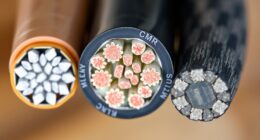Patch panels are central to organizing network connections, making setup, maintenance, and troubleshooting easier. You’ll find fiber optic and copper types, with some offering modular designs that grow with your needs. They help keep cables tidy, improve airflow, and guarantee reliable performance. Considering factors like port count and compatibility is key. If you want a clearer understanding of different types and their uses, stick around—that’s just the beginning.
Key Takeaways
- Patch panels serve as central connection points for managing multiple network cables, enhancing organization and troubleshooting.
- Different types include fiber optic, copper, and modular panels, selected based on network speed, size, and future expansion needs.
- They facilitate easy cable management, quick reconfiguration, and maintenance, improving network reliability and scalability.
- Proper installation, labeling, and grounding are essential for optimal performance and system stability.
- Future innovations include smart, IoT-enabled panels with remote management and real-time monitoring capabilities.
What Are Patch Panels and How Do They Work

Have you ever wondered how network cables connect and stay organized? Patch panels serve as central hubs, neatly managing multiple connections. They work by providing a dedicated port for each cable, allowing you to easily connect, disconnect, or reroute devices without chaos. For fiber optics, patch panels hold the delicate cables securely and ensure precise connections, maintaining high-speed data transfer. This is especially important during installation and maintenance, where proper setup can prevent future issues. Using hydrocolloid material in acne patches promotes healing by drawing out impurities and protecting the blemish. Wireless integration is also simplified with patch panels, as they organize wired connections that support wireless access points and routers. This setup helps prevent clutter and makes troubleshooting straightforward. By consolidating connections in one place, patch panels improve network reliability and scalability, making your entire system more efficient. Additionally, understanding the types of patch panels available can help you choose the best setup for your needs.
Furthermore, selecting the appropriate panel configuration can optimize your network’s performance and future expansion capabilities.
Common Types of Patch Panels

There are several common types of patch panels designed to suit different networking needs. One popular option is the fiber optic patch panel, which allows you to manage high-speed fiber connections efficiently. These panels are essential for networks that demand fast data transfer and minimal signal loss. Another widely used type is the modular design patch panel, which offers flexibility; you can add or remove ports as your network grows. Modular panels are ideal for mixed environments, supporting both copper and fiber connections within the same frame. By choosing the right type, you can optimize your network’s performance, scalability, and organization. Additionally, smart IoT technologies integrated into modern patch panels enable remote monitoring and management of network connections, improving efficiency. Quality assessment of patch panels ensures you select reliable components to prevent connection issues. Understanding the different patch panel types helps you build a reliable, adaptable infrastructure suitable for various network sizes and requirements. Whether you’re setting up a small office or a large data center, understanding these common patch panel types helps you build a reliable, adaptable infrastructure, and considering automation in network management can further enhance your system’s efficiency.
Advantages of Using Patch Panels in Network Setups

Using patch panels helps you keep your cables neatly organized, making it easier to manage your network. They also simplify changes, so you can add or move devices without hassle. Plus, troubleshooting becomes faster because you can quickly identify and resolve issues. Incorporating organization and decluttering strategies can further enhance your network setup by reducing clutter and improving accessibility. Additionally, understanding fiber optic technology can optimize your system’s performance and reliability. Staying informed about payment processing security measures can also protect your network from data breaches and fraudulent activities.
Organized Cable Management
Ever wondered how network setups stay neat and efficient? Patch panels make it easy to achieve organized cable management. They centralize connections, reducing clutter and preventing tangled wires. Here’s why you should consider them:
- Simplify cable organization for quick troubleshooting.
- Keep tidy wiring, improving airflow and cooling.
- Minimize accidental disconnections or damage.
- Enable easy additions or removals without disrupting entire systems.
Simplified Network Changes
Patch panels streamline network updates by making it easy to add, remove, or change connections without disrupting the entire system. With clear cable labeling, you can quickly identify and manage connections, reducing errors during modifications. Patch panels also support consistent grounding practices, ensuring your network remains safe and compliant as you make changes. Instead of rerouting entire cables, you simply reconfigure connections at the patch panel, saving time and minimizing downtime. This flexibility allows you to adapt your network infrastructure easily as your needs evolve. By organizing your cables neatly and maintaining proper grounding, you create a reliable environment that simplifies both routine updates and future scalability. Proper grounding techniques are essential for network safety and compliance. Additionally, implementing cable management best practices helps prevent clutter and potential damage, further enhancing network reliability. Ensuring proper grounding practices reduces the risk of electrical faults and improves overall system stability. Overall, patch panels make network adjustments straightforward, efficient, and less prone to mistakes, especially when combined with good maintenance practices.
Improved Troubleshooting Efficiency
When diagnosing network issues, having clear and organized connections considerably speeds up the troubleshooting process. Patch panels simplify cable routing, making it easier to identify and isolate problems quickly. They also enhance equipment interoperability by standardizing connections, reducing confusion during repairs. With a well-structured patch panel setup, you’ll experience fewer errors and less downtime. Consider these benefits:
- Faster identification of faulty cables or ports
- Easier access to individual connections for testing
- Reduced risk of accidental disconnections
- Streamlined upgrades and modifications
- Compatibility with various connection types, such as 3.5mm Jack, 1/4 inch Jack, Lightning, USB-C, or Bluetooth, ensures versatile integration into your network setup. Incorporating organized cable management practices can further improve overall system reliability and mindfulness of physical setup during maintenance. Additionally, understanding the importance of proper cable organization can prevent entanglements and damage, leading to more efficient troubleshooting and maintenance. Proper storage in a cool, dark place for cables and equipment can also prolong their lifespan and ensure optimal performance.
Factors to Consider When Choosing a Patch Panel

When choosing a patch panel, you need to take into account your connectivity requirements to ensure it supports your network devices. The size and number of ports also matter, as they determine how much equipment you can connect now and in the future. By focusing on these factors, you’ll select a patch panel that fits both your current needs and growth plans. Additionally, consider the communication and connection features that can enhance your network’s efficiency and resilience. Being aware of network standards can also help ensure compatibility and optimal performance with your existing infrastructure. Moreover, understanding sustainability practices in manufacturing can be beneficial as industry standards evolve toward more eco-friendly solutions.
Connectivity Compatibility Needs
Choosing a patch panel that matches your network’s connectivity needs is essential for guaranteeing seamless performance. To do this, consider these key factors:
- Compatibility standards – confirm the patch panel supports the specific standards your devices use, like Ethernet or fiber optics.
- Connector types – verify whether the panel accommodates RJ45, LC, SC, or other connector styles required by your equipment.
- Port configuration – match the number of ports to your current and future needs to avoid bottlenecks.
- Network speed requirements – select a patch panel rated for the data throughput your network demands, such as Gigabit or 10-Gigabit.
Size and Port Count
Selecting the right size and port count for your patch panel is crucial to guarantee your network can handle current traffic and future growth. When choosing, consider rack mounting space to ensure compatibility with your setup. Larger patch panels with higher port density allow for more connections in a compact form, optimizing your rack space. If your network is expanding, opt for a panel with extra ports to avoid frequent upgrades. Conversely, if your needs are modest, a smaller panel reduces unnecessary costs and complexity. Remember, selecting a patch panel with appropriate port count and size helps streamline cable management and future-proof your infrastructure. Balancing current demands with potential growth ensures your network remains efficient and scalable over time.
Installation and Maintenance Tips for Patch Panels

Proper installation and ongoing maintenance are essential for guaranteeing your patch panel functions reliably over time. To keep things running smoothly, focus on these key tips:
- Label cables clearly using cable labeling to simplify troubleshooting and future upgrades.
- Check grounding techniques regularly to prevent electrical issues and ensure safety.
- Keep the panel clean from dust and debris to avoid connectivity problems.
- Inspect connections periodically, ensuring all cables are securely plugged in and free of damage.
Future Trends in Patch Panel Technology

As technology advances, patch panel designs are evolving to meet increasing demands for speed, scalability, and management efficiency. Future trends include the integration of wireless capabilities, allowing seamless communication between patch panels and wireless networks. This wireless integration reduces cabling clutter and simplifies upgrades. Additionally, smart patch panels are gaining popularity; these devices incorporate sensors and IoT technology to monitor connection health, temperature, and usage in real-time. This data enables proactive maintenance, minimizes downtime, and enhances overall network performance. Expect more intelligent features that facilitate remote management and automation, making network infrastructure more adaptable and easier to scale. As these innovations develop, you’ll find patch panels becoming smarter, more efficient, and better suited to modern, high-demand network environments.
Frequently Asked Questions
How Do Patch Panels Affect Network Security?
Patch panels improve your network security by organizing connections, making it easier to monitor and control data flow. This reduces network vulnerabilities, as you can quickly identify and isolate suspicious activity or unauthorized access. By ensuring proper cable management, you enhance data protection, preventing accidental disconnections or breaches. Overall, patch panels help you maintain a secure, well-structured network environment, minimizing risks and safeguarding sensitive information effectively.
Can Patch Panels Be Used in Outdoor Environments?
Think of patch panels as the backbone of your network—yes, they can work outdoors if designed for it. You need outdoor durability and weather resistance, like a sturdy boat braving rough seas. Use specially sealed, weatherproof patch panels to guard against moisture, dust, and temperature changes. This guarantees your network stays reliable, even in harsh environments, allowing you to expand your connectivity without worry.
What Are the Cost Differences Between Fixed and Modular Patch Panels?
You’ll find that fixed patch panels generally cost less upfront compared to modular ones, making them ideal for simple setups. However, modular patch panels tend to have higher initial costs but offer lower installation costs because they are easier to customize and expand. The overall cost comparison depends on your needs; if you plan future upgrades, modular panels might save you money in the long run despite higher initial expenses.
How Do Patch Panels Impact Network Troubleshooting Efficiency?
Think of a patch panel as your network’s traffic controller, guiding data smoothly through cables. It boosts troubleshooting efficiency by keeping cable management tight and organized, reducing chaos. Clear label organization acts like street signs, helping you quickly identify connections. This streamlined setup allows you to pinpoint issues faster, saving time and minimizing downtime. With a well-structured patch panel, network problems become less of a maze and more of a straight path.
Are There Eco-Friendly or Sustainable Patch Panel Options Available?
Yes, eco-friendly patch panels are available. You can choose options made from eco-friendly materials like recycled plastics or sustainable manufacturing processes that reduce environmental impact. By selecting these sustainable options, you help lower your carbon footprint and promote greener technology practices. Look for vendors committed to sustainability, and you’ll find patch panels designed to meet both your networking needs and environmental responsibility.
Conclusion
Think of patch panels as the backbone of your network’s symphony, seamlessly connecting and organizing your cables like a conductor guiding an orchestra. When you choose the right type and maintain it well, you guarantee your network runs smoothly and effortlessly. Embrace these tools, stay ahead with future tech, and watch your setup flourish like a well-tended garden—robust, vibrant, and ready to grow. Your network’s success starts with a solid patch panel today.





